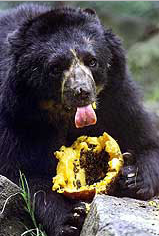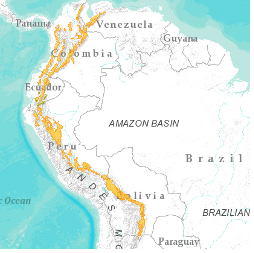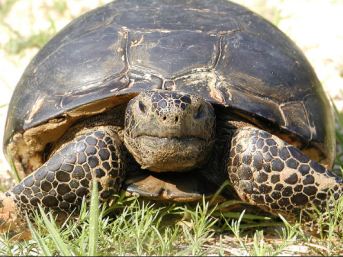Taxonomy:
- Kingdom: Animalia
- Phylum: Chordata
- Class: Mammalia
- Order: Carnivora
- Family: Ursidae
- Genus: Tremarctos
- Species: ornatus
- Other Name: Andean Bear
- Average Height: 5 to 6.5 ft (1.5 to 2 m)
- Average Male Weight: 220 to 440 lbs (100 to 200 kg)
- Average Female Weight: 77 to 180 lbs (35 to 82 kg)
- Lifespan: 20+ years
One of the smallest members of the bear family, the diminutive spectacled bear is also South America’s only bear species. The intensely shy bears prefer the lush, dense, isolated cloud forests on the slopes of the Andes, climbing as high as 14,000 feet (4,3000 meters). They will descend to search for food though and have been seen in widely differing habitats, from rainforests, steppe lands, and coastal deserts, to the high Andean moorland.
The spectacled bear is found from Venezuela to Northern Argentina, including Colombia, Ecuador, Peru, and Bolivia. According to some researchers, the greatest number of bears is to be found on the borders between Colombia, Ecuador, and Peru.
Physical Description:
The bear has a robust and stocky build, with a short and muscular neck as well as short but strong leg. Its head is rounded, with small round ears, and the snout is relatively short compared to other bear species. As with all bears, it can also walk on the soles of their feet. Medium sized, the bear also have a longer front than rear legs, making it an excellent climber. Overall, the male spectacled bear is much larger than the female, up to 50% bigger.

A spectacled bear’s dense fur is usually black, although it can have dark red-brown tones. It will also have white to pale yellowish rings that encircle its eyes, resembling large eyeglasses, as well as around the muzzle, neck, and chest. However, these lines don’t always have to encircle the eyes and some individuals will lack the distinctive markings altogether.
Its long, curved, sharp claws are used for climbing trees and digging into insect mounds for food. The bear also has a very strong jaw and wide, flat molars to help them chew through tough vegetation such as tree bark. Because of the warm climate where they live, their fur is reasonable thinner than most other bear species and they do not have to hibernate. Its short tail, about 3 inches or 70 mm long, is completely hidden by the fur.
Diet:
Spectacled bears have an omnivorous diet, although they are fairly specialized in fruit and different parts of several plants. Besides the giant pandas, they are probably the most herbivorous bear species. They feed high up in trees as well as on plants growing on the ground. They seem to have a strong preference for bromeliad and fruits, but have also been observed eating moss, cacti, orchids, bamboo, honey, tree wood, and palms.
 Occasionally, they will supplement their diet with meat, eating insects, small rodents, birds, and even small cows. This makes them the largest carnivores in South America.
Occasionally, they will supplement their diet with meat, eating insects, small rodents, birds, and even small cows. This makes them the largest carnivores in South America.
Spectacled bears have been known to raid farmers crops, especially maize, which often results in the bears being shot. Despite this, they have rarely been observed killing livestock and will readily scavenge from a carcass.
Behavior:
Though generally diurnal, spectacled bears are shy, elusive, and peaceful creatures, avoiding contact with humans. In general, they are usually solitary, but may be found occasionally in relatively high concentrations, when favorite food items are abundant.
As highly agile climbers, the bears have been known to spend their time sitting in a tree for days on a platform they formed from broken branches, waiting for fruit to ripen. They will also form these nests to rest as well.
Pairs are formed only for reproduction between March and October, indicating an ability to reproduce at different times of the year. Females are capable of planning their pregnancy and labor to make sure their food supply is ample at the time of giving birth. Like most bears, the pregnancy of the spectacled bear can be delayed implantation where the fertilized ovum floats in the uterus for a period of time before attaching to the wall of the uterus and continuing developing. If there is a season when food is extremely scarce, the embryos can simply be absorbed into the mother’s body and she will not give birth that year.
After a gestation period of 5.5 to 8.5 months, the female will usually give birth to one to three cubs between December and February. The tiny and helpless cubs will weigh between 10 to 18 ounces at birth and their eyes shut for the first month. They are born black in color, already sporting the white or yellowish ‘spectacle’ markings. For the next six to eight months, the cubs will hitch a ride on the mother’s back. The cubs will remain with the mother for at least a year and will not sexually mature until between four to seven years old.

Conservation and Threats:
Population data are sketchy, but some estimates suggest fewer than 3,000 spectacled bears may remain in the wild today. Their numbers suffer primarily from the destruction and fragmentation of their habitat due to the construction of roads and infrastructure development as well as destruction of forests for illicit crops such as coca and opium poppy. Habitat has also been destroyed for the use of grazing areas for cattle farming. Current land use patterns include the felling of trees, land clearing, and extraction of timber and firewood for farms in the higher mountainous areas. Because of these developments, the original habitat of the spectacled bear has fragmented into at least 113 patches of wilderness in the mountainous region between Venezuela and northern Peru.
Hunting is also another major cause of population reduction of this species. Local inhabitants kill these unique bears for diverse reasons including: subsistence hunting, protection against attacks to livestock and crops, and fear of the animal due to cultural reasons. They are also hunted for their parts for the wildlife trade. There is local demand for items such as its fat, skin, claws, and meat. Particularly, its gall bladders are valued in traditional oriental medicine, fetching a high price on the international market. Recent estimates put the price at US $150 for one, which is five times the average monthly wage in Ecuador. There is also a large market for bear paws, with one paw bringing in between US $10 to $20. It is calculated that around 200 bears are hunted down annually in the region.

Lack of knowledge about the distribution and status is a problem throughout the region. In many areas, information about the status of spectacled bears is outdated, or particularly in the southern portion of the range, simply non-existent. The absence of knowledge makes it difficult to develop realistic management plans for the conservation of this species or to monitor changes in its distribution. Despite this, the species is legally protected, though enforcement is underfunded. International trade is banned after being listed under Appendix I of CITES. It is also listed as ‘vulnerable’ to extinction on the IUCN Red List.
There are also a number of national parks that contain spectacled bears. But like legal enforcement, these often vast areas are massively understaffed and therefore, ineffective for their conservation. Some of these protected areas have populations not large enough for the species’ survival throughout its range. Kölner Zoo in Germany coordinates the International Studbook for this species, and a captive breeding programme is also underway in Venezuela.
The World Wildlife Fund (WWF) has led the development of a regional conservation strategy for the species in the Northern Andes, with the support of other international organisations and local NGOs from the region. The Andean Bear Conservation Project of Ecuador also directs a program of reintroduction into the wild for spectacled bears that have been rescued from hunters or kept in captivity, while in Venezuela the Andígena Foundation is carrying out a series of environmental education and research projects for spectacled bear conservation in the Venezuelan Andes, and advising conservation initiatives in other countries within the range of this charismatic bear
Interesting Facts:
- Protecting the habitat of the forest’s largest animal automatically benefits other forest dwellers, bringing advantages to the whole ecosystem. For this reason, the spectacled bear is considered a flagship or umbrella species.
- The fictional children’s character Paddington Bear is a spectacled bear, having come all the way from “darkest Peru”.
- The spectacled bear is thought to be the best climber of all the bear species.
- They are the most vegetarian of bears; only roughly 5% of their diet is meat.
- All other types of bear have 14 pairs of ribs, however, the spectacled bear only has 13.
- The spectacled bear is the second largest terrestrial mammal in South America.
References + For More Reading
Animal NatGeo: Spectacled Bear
San Diego Zoo: Andean (Spectacled) Bear
Arkive: Spectacled bear (Tremarctos ornatus)
Animal Corner: Spectacled Bear
Bears of the World: Spectacled Bears
The Animal Files: Spectacled Bear


















